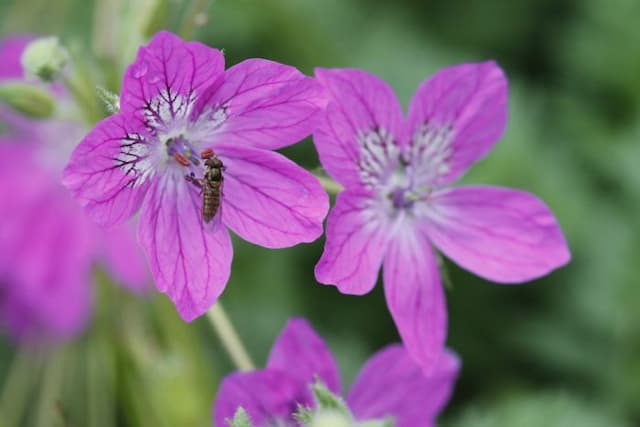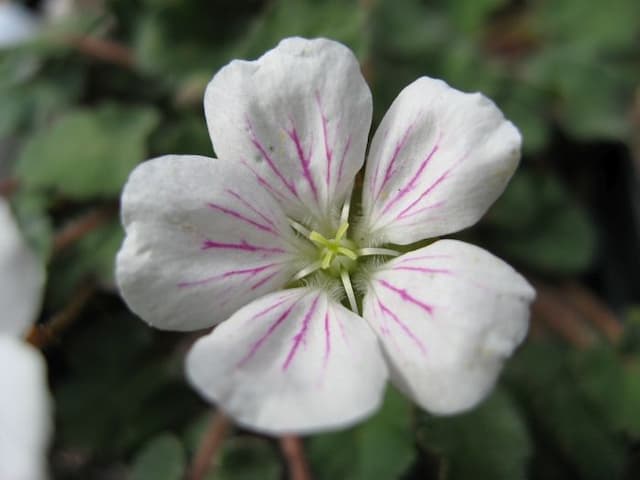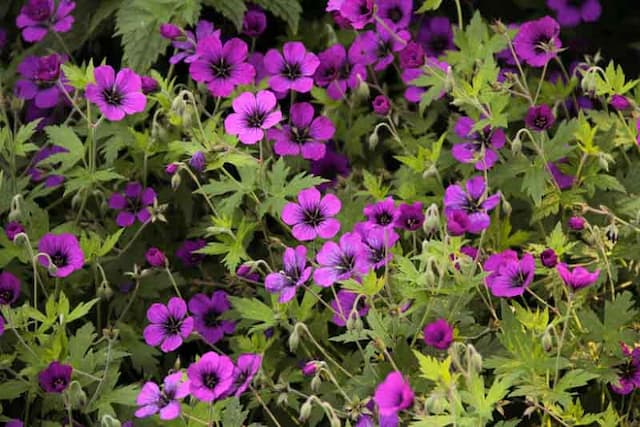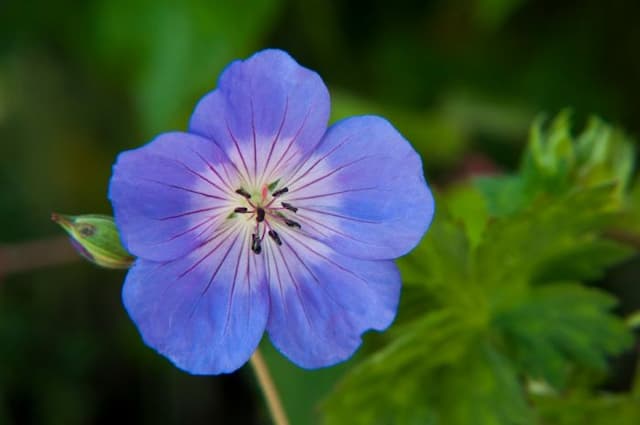Rose Geranium Pelargonium 'Rose' (Sc)

ABOUT
Pelargonium 'Rose', often known as scented geranium, is a popular aromatic plant that is most valued for its fragrant foliage. This variety specifically exudes a rose-like scent, which is why it carries the name "Rose." The appearance of the scented geranium is characterized by bushy, leafy green growth. The leaves of the Pelargonium 'Rose' are typically rounded with slightly scalloped edges and a soft texture. They often have a green color that can range from light to dark, and some varieties may exhibit variegation or contrasting colors, such as pale yellow or cream margins. Flowers of the scented geranium can be small but quite showy, appearing in clusters above the foliage. They usually come in shades of pink or purple, though some can be white or have darker markings on the petals. The flowers have five petals, with the upper two being larger and often a different shade or marked differently than the lower three. The stems of the Pelargonium 'Rose' are semi-succulent, meaning they have some water storage capability, and are typically branching, forming a mounded shape. The plant has a tendency to become woody at the base as it matures. Overall, it's the foliage that is the main attraction for this plant due to its fragrant, rose-scented leaves, which release their aroma when touched or brushed against. Scented geraniums are often grown in gardens and pots for their aroma and aesthetic appeal.
About this plant
 Names
NamesSynonyms
Rose-scented Pelargonium, Rose Geranium, Sweet-scented Geranium.
Common names
Pelargonium 'Rose'.
 Toxicity
ToxicityTo humans
The common name for Pelargonium 'Rose' is rose-scented geranium. Generally, rose-scented geraniums are considered to be non-toxic to humans. There are no well-documented cases of poisoning or serious side effects from ingesting parts of this plant. However, as with any plant material, individual sensitivities and allergic reactions could occur, potentially leading to mild symptoms such as skin irritation or gastrointestinal discomfort.
To pets
Rose-scented geraniums are also known as non-toxic to pets such as dogs and cats. They are typically safe in households with pets, and there are no commonly reported symptoms of poisoning from these plants. Nevertheless, some animals might experience mild gastrointestinal upset if they ingest significant amounts of plant material, which could manifest as vomiting or diarrhea. It's always prudent to monitor your pets and keep an eye on their habits with houseplants, but the rose-scented geranium is generally considered safe.
 Characteristics
CharacteristicsLife cycle
Perennials
Foliage type
Evergreen
Color of leaves
Green
Flower color
Pink
Height
1-2 feet (30-60 cm)
Spread
1-2 feet (30-60 cm)
Plant type
Herb
Hardiness zones
10
Native area
South Africa
Benefits
 General Benefits
General Benefits- Easy to Grow: The plant is known for being low-maintenance and easy to care for, making it an ideal choice for novice gardeners.
- Aesthetic Appeal: With its bright blooms and attractive foliage, the plant adds color and beauty to gardens, balconies, and indoor spaces.
- Scent: The pleasant rose-like fragrance of the flowers can perfume the air in the immediate vicinity, creating a soothing environment.
- Drought Tolerance: Once established, these plants can tolerate periods of low water, making them suitable for xeriscaping and water-wise gardens.
- Versatility: It can be grown in pots, containers, hanging baskets, or directly in garden beds, offering a range of landscape uses.
- Long Blooming: The plant has a lengthy blooming period, providing flowers for much of the spring and summer months.
- Attracts Pollinators: The flowers can attract beneficial insects such as bees and butterflies, supporting local ecosystems.
- Resistant to Pests: It is generally resistant to many common garden pests, reducing the need for chemical pest control.
 Medical Properties
Medical Properties- Anti-inflammatory: Pelargonium 'Rose' extracts have been studied for their potential to reduce inflammation.
- Antibacterial: The essential oils and extracts of the plant have shown antibacterial activity.
- Antiviral: Some studies have indicated that Pelargonium 'Rose' may have antiviral properties.
- Expectorant: Traditional use includes aiding in relief of respiratory issues such as colds and bronchitis.
- Immune Support: It is believed to have immune-boosting effects.
 Air-purifying Qualities
Air-purifying QualitiesThis plant is not specifically known for air purifying qualities.
 Other Uses
Other Uses- Pelargonium 'Rose', commonly known as rose geranium, can be infused into sugar to impart a floral flavor for use in baking and desserts.
- The leaves of rose geranium can be layered in cakes or pastries to infuse them with a subtle rose flavor during the cooking process.
- Rose geranium's aromatic leaves can be stitched into sachets and placed in drawers or closets to impart a fresh rose scent to linens and clothing.
- The essential oil of rose geranium can be used in homemade natural perfumes or body sprays for a light and refreshing floral fragrance.
- Leaves of rose geranium can be used in potpourri mixes to enhance the overall aroma and prolong the scent in a room.
- Rose geranium can be planted in outdoor gardens as a companion plant to repel pests from vegetables and other herbs.
- The plant can be macerated into liquid and used as a natural spray to deter insects from indoor and outdoor living spaces.
- Crushed rose geranium leaves can be rubbed onto the skin to serve as a temporary natural mosquito repellent.
- Rose geranium can be used to flavor homemade jams, jellies, and preserves, adding a unique, aromatic twist to traditional recipes.
- The visually appealing leaves and flowers of rose geranium can be used in floral craftwork, like wreath-making, for decorative purposes.
Interesting Facts
 Feng Shui
Feng ShuiThe Geranium is not used in Feng Shui practice.
 Zodiac Sign Compitability
Zodiac Sign CompitabilityThe Geranium is not used in astrology practice.
 Plant Symbolism
Plant Symbolism- Comfort - Pelargonium 'Rose', commonly known as scented geranium, often symbolizes comfort due to its soothing fragrance which is believed to help calm the mind and ease tension.
- Health - The scented geranium is associated with health for its use in traditional medicine and its ability to purify the air, promoting a healthier environment.
- Femininity - Its delicate rose-like scent and soft petals are often linked to the classic attributes of femininity such as beauty, grace, and gentleness.
- Friendship - With its pleasant aroma and hardy nature, scented geraniums are often given as gifts between friends to represent enduring affection and mutual appreciation.
- Surprise - The plant's various scents and unexpected aroma from a non-rose plant can embody the element of surprise or the unexpected in life.
 Water
WaterThe Scented Geranium should be watered deeply when the top inch of soil feels dry to the touch, which typically means water about once a week. Depending on the climate and indoor conditions, this may vary slightly. Use approximately one to two cups (8-16 ounces) of water per plant, ensuring you water the soil directly and avoid wetting the leaves to prevent fungal diseases. During the winter months or in cooler temperatures, reduce the frequency of watering as the plant's growth slows down. Remember to provide good drainage to prevent waterlogged soil, as this can lead to root rot.
 Light
LightScented Geraniums prefer bright, indirect sunlight and should be positioned in a spot that receives this kind of light for most of the day. They can tolerate some direct sun, but too much can scorch their leaves, so a location near an east or west-facing window is ideal. If the light is too intense, use sheer curtains or blinds to diffuse the direct sunlight.
 Temperature
TemperatureScented Geraniums thrive in temperatures ranging from 55 to 70 degrees Fahrenheit. They can tolerate a minimum temperature of around 30 degrees Fahrenheit and a maximum of about 80 degrees Fahrenheit. However, for optimal growth and flowering, keep them in the ideal range and avoid exposure to drafts and sudden temperature changes.
 Pruning
PruningPruning Scented Geraniums encourages bushy growth and prevents legginess. Snip off any dead or yellowing leaves and trim back leggy stems, ideally during early spring or summer. Prune regularly, about every couple of months, to keep the plant compact and to promote vigorous growth. The best time to prune is after a flush of bloom, to encourage another round of flowers.
 Cleaning
CleaningAs needed
 Soil
SoilThe scented geranium prefers a soil mix that is well-draining with good aeration, typically a blend of potting soil, peat, and perlite or sand. The ideal pH for this plant is slightly acidic to neutral, ranging from 6.0 to 7.0.
 Repotting
RepottingScented geraniums should be repotted every one to two years or when they outgrow their current pot, to provide fresh soil and encourage healthy growth.
 Humidity & Misting
Humidity & MistingScented geraniums do best in average household humidity levels; excessive humidity can lead to fungal issues, so aim for about 30-50%.
 Suitable locations
Suitable locationsIndoor
Place in bright light, away from drafts, watering when soil is dry.
Outdoor
Grow in full sun to part shade; shelter from strong winds.
Hardiness zone
9-11 USDA
 Life cycle
Life cycleThe life cycle of the Pelargonium 'Rose', commonly known as Rose Scented Geranium, begins with the germination of seeds in moist, well-draining soil under warm temperatures. Seedlings emerge with young leaves that gradually mature into the plant's characteristic deeply lobed, rose-scented foliage. The vegetative stage follows, where the plant experiences robust leaf growth and develops a sturdy stem structure. Next is the flowering stage, typically in spring or summer, where the plant produces clusters of small, pink to purple blossoms that attract pollinators. After pollination, the plant may produce small, seed-containing fruit if conditions are favorable. Finally, as a perennial, it enters a dormancy phase in cooler climates or periods of drought, reducing growth until favorable conditions return.
 Propogation
PropogationPropogation time
Spring-Early Summer
The most popular method of propagating a geranium, specifically the Pelargonium 'Rose' variety, is through stem cuttings. The best time to take cuttings is either in late summer or early autumn. To propagate by this method, you select a healthy stem that is about 4 to 6 inches (10 to 15 centimeters) long and cut just below a leaf node using a sharp, clean knife or shears. It's important to remove any flowers or buds along with the lower leaves to direct the plant's energy to root development. The cut end can be allowed to callous over for a few hours before being planted in a mix of potting soil and perlite. The cutting should be watered lightly and placed in indirect light until roots develop, which usually takes a few weeks. Maintaining high humidity around the cutting by covering it with a clear plastic bag or container can aid in rooting success.






![Cranesbill [Rothbury Gem]](/_next/image?url=https%3A%2F%2Fplants-admin.emdemapps.com%2Fimages%2Fplants%2F%2Fimages%2F604b6243984c2.png&w=640&q=75)


